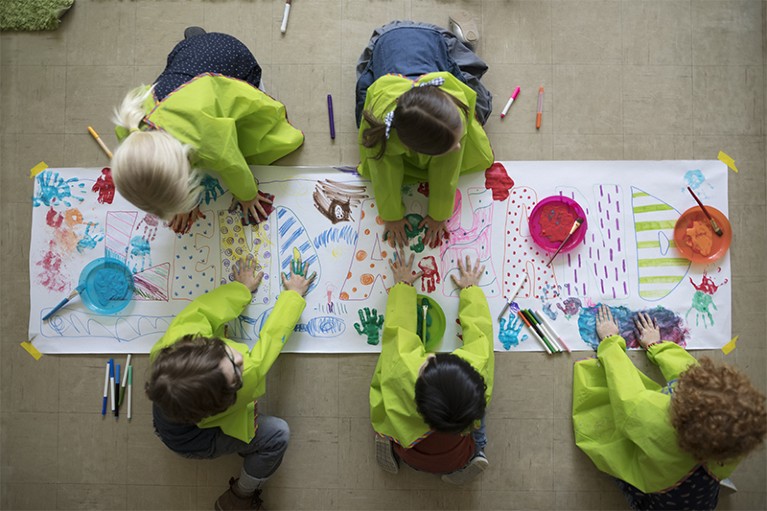
Credit: Hero Images/Getty Images
In 2014, Darcy Ernst was nearing the end of her graduate training in integrative biology at the University of California, Berkeley, and was stepping onto the job market. To increase her visibility, she was determined to hit the conference circuit. “I was still nursing my son when I had to go to a major international meeting in Australia,” says Ernst. With child in tow, she presented a poster and a talk about her academic work. “The exposure and having that on my CV was useful,” she says.
The trip was not easy for Ernst. She could find grant funding to cover her own travel costs “but it was such a shuffle to make this work with a nursing baby, where there’s no good answer: you’re either paying for someone to come with you, or you’re not going, or you go by yourself with the baby.” Eventually, Ernst had to pay out-of-pocket to find help with childcare. “We had to cobble together the rest of the money so that dad could come with [me] to help look after the baby.”
In March 2018, Ernst and a group of 45 mothers in science published a set of guidelines in the opinion section of the Proceedings of the National Academy of Sciences (PNAS) titled ‘How to tackle the childcare–conference conundrum’ (R. M. Calisi et al. Proc. Natl Acad. Sci. USA 115, 2845–2849; 2018).
The group was led by Rebecca Calisi Rodriquez, a faculty member at the University of California, Davis, who started writing the guidelines out of sheer frustration with the lack of childcare provisions at conferences.
“Going to meetings with young children is extremely difficult for many different reasons,” says Calisi Rodriguez. “There have been many conferences that I’ve not been able to attend because I didn’t have the support I needed to bring my children.”
Although she started writing the piece on her own, Calisi Rodriguez soon realized she needed input from others. By reaching out to other mothers in science in her network, Calisi Rodriguez received feedback on her list. Together, 46 scientists shaped and created the guidelines that fell into four categories under the acronym CARE: Childcare; Accommodate families; Resources; and Establish social networks.
The impact of the PNAS piece, which is among the top-scoring 5% of articles in the Altmetric database, is part of a wider trend towards equality in science. In the United Kingdom, for example, universities are recognized for their efforts in creating gender-equal working environments through the Athena SWAN Charter, which has been running since 2005 and has direct influence over government funding decisions. In January 2018 the programme moved to the United States under the name SEA (which stands for STEM Equity Achievement) Change. Conference organizers and attendees are joining the movement.
“Working parents are a major part of the workforce and making them feel welcome to combine their work needs and family life … is taking on more importance,” says Dana Kiffmann, who manages KiddieCorp Inc, a US-based company that provides childcare to about 33 scientific conferences per year.
In 2012, Katherine Heller, an artificial intelligence researcher at Duke University in North Carolina, took her oldest child to the Neural Information Processing Systems (NeurIPS) conference at which she and her partner at the time were speaking. “We thought we'd switch off, but spent most of our time doing childcare and not attending the conference,” she says.
Heller is the diversity and inclusion co-chair for the next NeurIPS meeting in Montreal, Canada, which will be held in December 2018. As well as using Kiffmann’s KiddieCorp for onsite childcare for researchers at the conference, Heller and her co-chair have secured childcare grants and sourced additional local childcare support.
When meetings do not provide on-site childcare, parents can look for grants and approach funders and universities for help. The London Mathematical Society, for example, offers a £200 grant for UK-based families to attend meetings. Other groups, such as the Engineering and Physical Sciences Research Council in the UK and the Materials Research Society in the US also offer financial support to help parents attend conferences.
Heller and her co-chair have worked with Alphabet, the holding company of Google and other technology companies, to provide a childcare grant programme that allows NeurIPS participants with children to apply for up to US$100 per day to cover the cost of childcare.
Conference organizers are increasingly aware of the need to provide adequate support for caregivers at their meetings. As a direct result of the PNAS column, the San Diego-based Walter E. Washington Convention Center is making structural changes to accommodate researcher parents attending the Society for Neuroscience meeting in December 2018. The changes include a mobile lactation pod for nursing mothers. The Tampa Marriott Waterside and Tampa Convention Centre, Florida, installed nursing rooms and fridges for breastfeeding mothers in advance of the Society of Integrative and Comparative Biology meeting in January 2019. There will also be free childcare at the meeting.
Although many challenges remain, changes are being made. Even if no official support is offered at a conference, social support is still there, says Ernst. “When you do travel with your child, people come out of the woodwork to help you with the baby.”


 The 2019 Events Guide
The 2019 Events Guide
 The future of the scientific conference
The future of the scientific conference
 How to give a great scientific talk
How to give a great scientific talk
 Milestone meetings
Milestone meetings
 Make it easier for me to deliver childcare at conferences
Make it easier for me to deliver childcare at conferences
 Partner content: Keeping the molecular biology flame burning bright
Partner content: Keeping the molecular biology flame burning bright
 Partner content: A flourishing, cutting-edge conference programme
Partner content: A flourishing, cutting-edge conference programme



